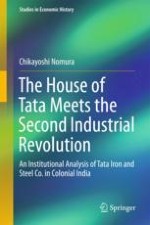2018 | OriginalPaper | Chapter
3. TISCO During the Decade of the 1900s: The Formation Period
Author : Chikayoshi Nomura
Published in: The House of Tata Meets the Second Industrial Revolution
Publisher: Springer Singapore
Activate our intelligent search to find suitable subject content or patents.
Select sections of text to find matching patents with Artificial Intelligence. powered by
Select sections of text to find additional relevant content using AI-assisted search. powered by
